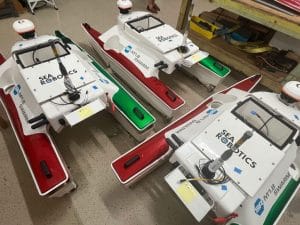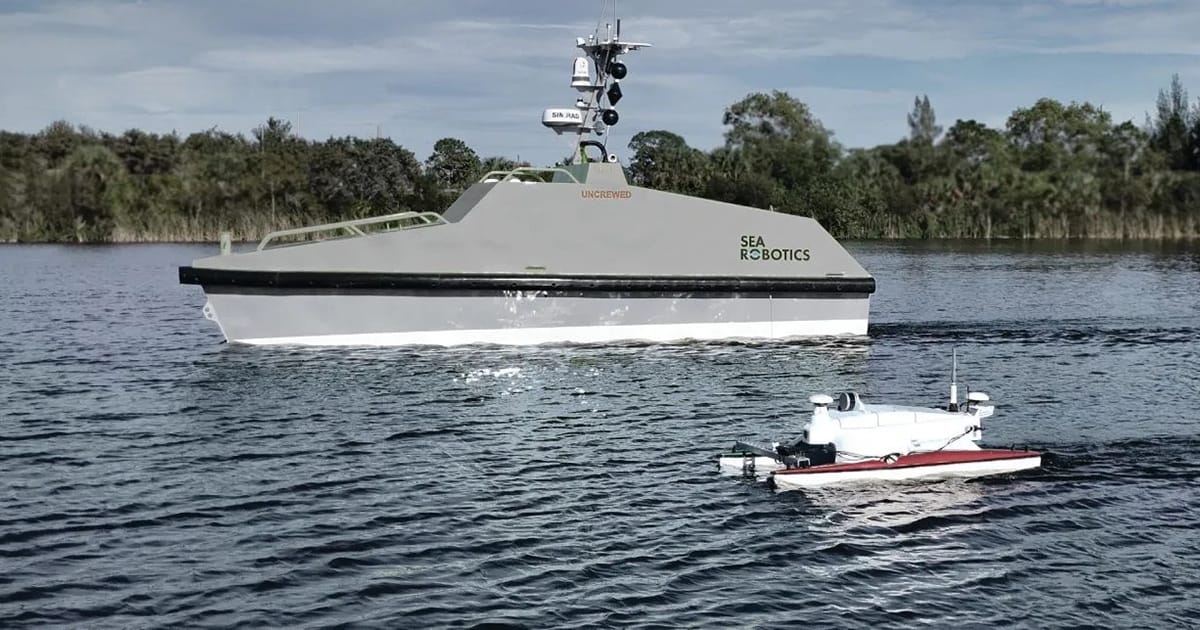In years past, most USV technology development was tied to a specific set of in-field applications, often defense related. However, the technical, economic, and cultural variables have shifted. Today, there is a growing acceptance among marine professionals that deploying USVs for a broadening range of at-sea tasks represents a cost-effective means of scaling down manned operations and ultimately enabling leaner, greener, and safer operations.
As a result, the USV industry is ramping up R&D efforts to target specific customer profiles, which has led not only to a steep increase in commercially available USVs but a diversifying range of models in terms of form and factor.
PORTFOLIO WITH PURPOSE
SeaRobotics focuses on serving two user groups—commercial marine survey firms and coastal defense and security agencies. These partners have been instrumental in shaping the company’s current USV portfolio, which is organized by three vehicle classes: Surveyor Class (compact, man-portable USVs best suited to coastal and inland waters); Utility Class (mid-size multipurpose models that support weightier, interchangeable payloads); and Endurance Class (a series of larger hybrid diesel-electric vessels designed for longer autonomous deployments in higher Sea States).
Of late, there has been a spike in demand for SeaRobotics’ most compact USV, the SRSurveyor M1.8. Supported by an EdgeTech 2205 and Velodyne LiDAR, this fully integrated 1.8-m USV delivers synchronized data capture of two frequencies of side scan, motion tolerant side scan, wide swath bathymetry, backscatter, LiDAR point cloud data, and discharge data. The SR-Surveyor M1.8 is easily portable and quick to deploy, making it an ideal force multiplier in hard-to-navigate or potentially hazardous waters.
EXTENDING REMOTE OPERATIONS
The ability to operate multiple units remotely (SeaRobotics teams have successfully run multiple USVs from its Swarm Fleet from a remote command center over 5,000 miles away) brings a new dynamic to the concept of “over-the-horizon” deployments. Having separate units complete survey lines simultaneously in multiple locations from one shore-based control is now a reality.
At the other end of the size spectrum, the company’s Endurance Class USVs serve longer missions. The latest model, the SR-Endurance 8.0, is designed for multi-week surveillance exercises, seabed mapping, and infrastructure inspection campaigns. It boasts a hybrid diesel-electric power system capable of supporting missions with a range of over 1,000 nautical miles with varying levels of autonomy. Capable of a top speed of 9 knots, the USV can run campaigns up to 9 days at a survey speed of 5 knots.
Further, with an onboard payload capacity of 600 kg and a 3.7 m x 1.5 m aft deck bay, a moon pool, and a dry enclosure with digital, serial, ethernet, and power, the SR-Endurance 8.0 is equipped to handle a wide range of sensors, as well as the launch and recovery of ancillary assets, such as smaller USVs—like the SR-Surveyor M1.8—as additional force multipliers.
Radar, LiDAR, AIS, and GNSS, and 6 cameras—4 fixed, 1 PTZ, and 1 FLIR—come as standard to optimize image capture and ensure obstacle detection and avoidance procedures when running autonomously.

This spotlight appeared in ON&T Magazine’s 2025 July Special Edition, Uncrewed Vehicles Buyers’ Guide, to read more access the magazine here.
